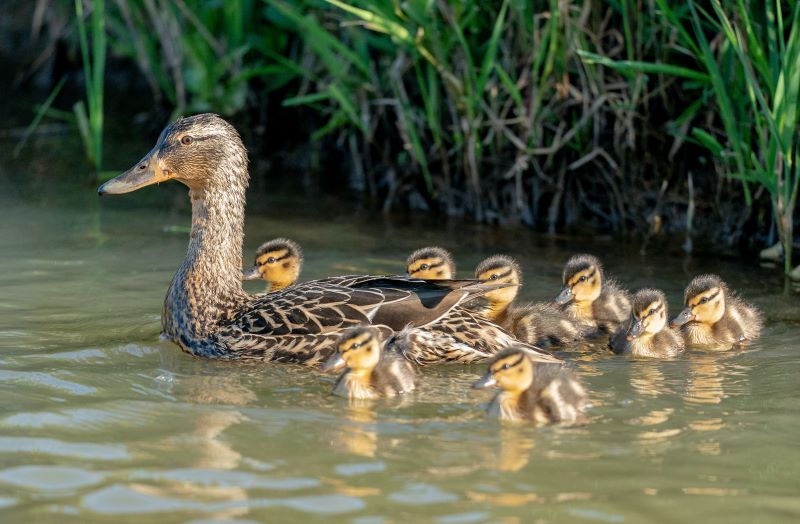The Miracles of Mallard Motherhood
By Gale McCreary
As raucous blue jays argue over nesting sites and crows convene in swarthy flocks, a lone duck can be seen drifting along the river’s edge quacking. She is announcing her availability, not that common for a Mallard hen. These drab-coated females usually are claimed by handsome green-headed drakes early in the season and remain paired with them for years.
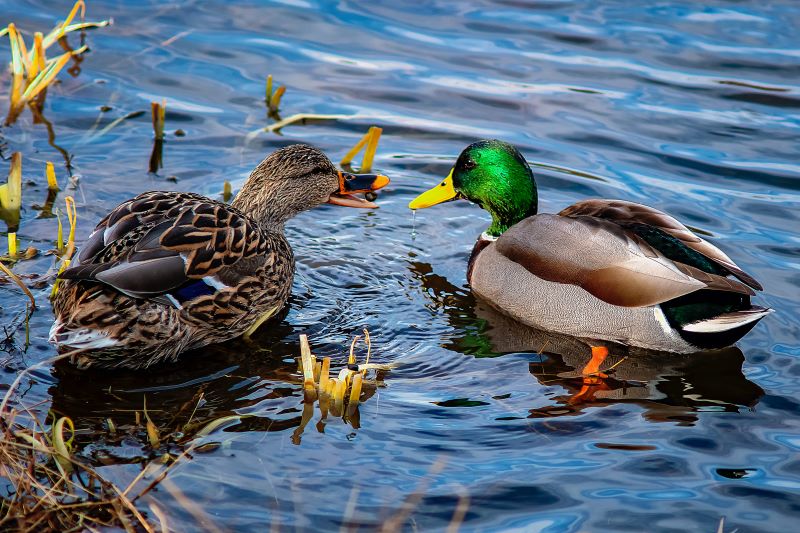
The Mallard, or wild duck, is strongly migratory and can be found almost everywhere in the Northern Hemisphere, straying south nearly to the equator and as far north as the Arctic tundra for breeding. In most of the United States, it is considered a year-round resident. They prefer shallow wetlands, both fresh and saltwater, and have adapted so well to human habitation that they can be found in parks, lakes, and swimming pools. We all remember the children’s classic picture book by Robert McCloskey, “Make Way For Ducklings,” where a Mallard pair hatches their brood of ducklings on the banks of the Charles River, and then requires the help of the Boston policemen to cross into the Public Garden, where they live happily ever after.
I was planning a springtime surprise for my grandsons and had mail ordered Mallard duck eggs so that the boys could experience the miracle of hatching and the delight of playing with fluffy baby ducks. This is how most people who buy tiny Easter chicks and ducklings for the annual festivities view their gifts. Of course, they quickly grow into hens, roosters, or drakes that are messy and noisy, and most become unwanted pets. “They’re bought as novelties,” Stephen Zawistowski, science advisor for the American Society for the Prevention of Cruelty to Animals, gruffly explains. “Pets,” Zawistowski says, “should be thought of as companions.” Ours would be different — they would be native Mallard ducks that would live free in the garden and ultimately could fly away to join others that reside nearby on the San Lorenzo River.
The dozen light blue-gray-greenish eggs arrived by mail, securely packed in form-fitting foam, along with a single sheet of detailed instructions on “Incubating Eggs.” My old incubator, left over from a long-ago science fair, was simply a styrofoam box with a thermostat and heater and did not have the advanced capabilities of air circulation, humidity regulation, egg turning, and intermittent cooling. For the next 28 days, it was my job to imitate a moist warm mother duck who spends her day rearranging her brood of eggs and taking short breaks in the river.
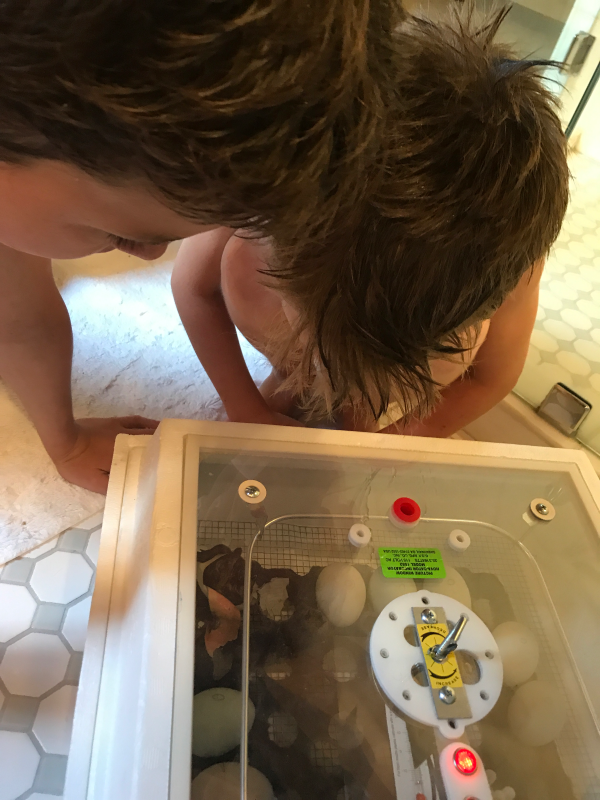
The timing, however, was perfect. The family had arrived for the long holiday weekend, and on Friday, Bobby came running calling, “Grandma, I can hear the ducklings inside their eggs!” We all three crouched around the incubator to listen to the tiny clicks coming from within the solid shells. Inside, the ducklings had pierced the inner membranes of the eggs and begun ventilating their new lungs with the air in the air sacs. We cupped a clicking egg and held it in front of our powerful flashlight. There, from out of the solid reddish mass filling most of the egg, was the blurred outline of a beak poked into the bright air space. This sense that “it is happening” gripped all of us. That a simple egg, the type you cracked into sizzling butter on a hot frying pan, could redefine its every molecule into a living, breathing life form was a biological wonder too complex to comprehend.
“We need to help it out!” Bobby’s older brother Jack exclaimed.
“No, they are not ready yet. We need to click back,” I replied, “and let them all know that we’re out here waiting for them when they are ready.”
Much takes place in the last few days of the duckling’s egg-bound life. The allantois which has functioned as the embryo’s lungs, carrying oxygen from the shell’s membrane, shrinks as the duckling’s own lungs begin to function. The remaining yolk, namely the food supply for the first weeks, is absorbed into the gut, and the gut sealed from the outside. And the clicks are part of early embryonic communication that causes the slower embryos to quicken their metabolism and tissue development in order to synchronize hatching. In the nest, the mother would quietly cluck back, a communication that will further regulate the hatching as well as start her connection and create a cohesive bond.
Bobby and Jack rose early Sunday morning to the first star-shaped crack of a shell, where the little egg tooth on the duckling’s beak had pushed through. More audible peeping, and throughout the day, one by one, the ducklings pecked, twisted, and squirmed their way out of their shells until they flopped out wet and exhausted. With oversized feet and a gangling neck, we could not imagine how such a body could have been packed into an egg. Hours later, their slick tan feathers dried, there were six fluffy yellow-chested mottled brown impossibly adorable ducklings huddled together doing innate duck-like things such as preening themselves and each other. We moved them to a big towel-lined box with a heat lamp, a tray of water, and a feather duster we called “Mom.”
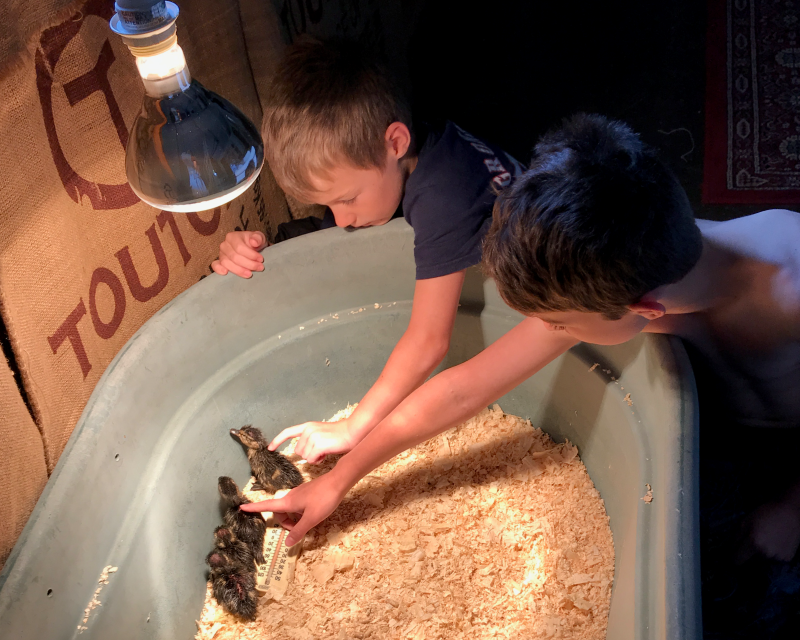
Within days the ducklings were voraciously pecking up baby duck pellets and faithfully following Bobby and Jack as the boys crawled quacking across the garage floor. We all delighted in such over-the-top cuteness! Within a week the ducklings were swimming in a play pool, and a month later the whole smelly gang of six was moved outside to a netted coop. Even that became a daily cleaning effort, so the teenage ducks were allowed to roam outside most of the day, returning to a newly constructed double-wired pen at night.
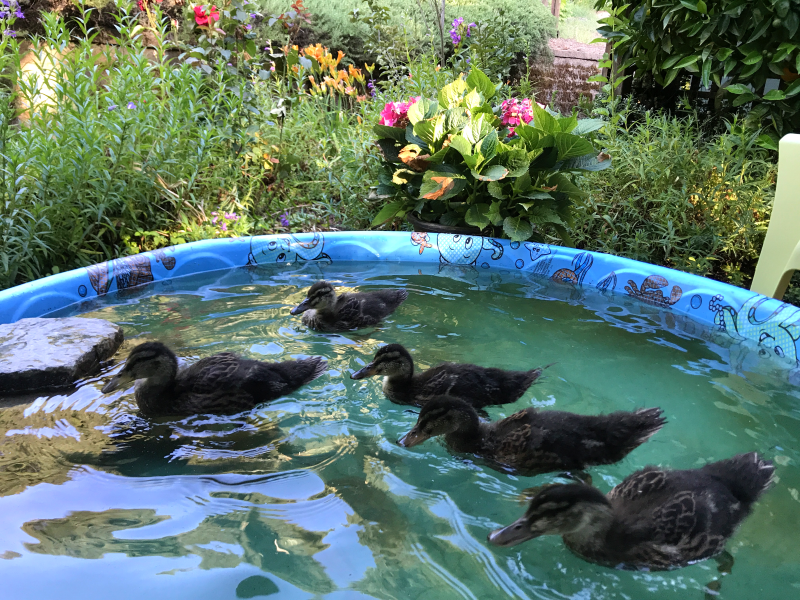
Today only two ducks remain. We’ve told ourselves that the others have flown away. Quacker Jack, now a handsome drake with a striking white ring around his mahogany colored neck and bright iridescent blue speculum on each wing, parades around with his dappled brown hen like a Homecoming couple. Soon she will arrange a nest out of the pile of grass hay in her nesting box and with patience and grace, manage the duties of heat distribution, humidity regulation and egg turning. Somehow the blue jays will know when hatching day is near, and an entire band of these loud-voiced marauders will swoop around the duck’s coop. The crows will be the next ones to arrive, and ultimately screeching hawks will keep a long-distanced eye on the field. When Mother Duck emerges from her safety, followed by at least 10 to 12 successfully hatched ducklings, she will be hard-pressed to teach them to hide, swim, dive, and escape the beaks and claws awaiting them. While her hatching rate is twice as good as mine in the incubator, without constant human surveillance and protection, she is unlikely to have any of her ducklings survive the four months to adulthood.
“This time when those eggs come,” I ask Bobby and Jack, “should we eat them or let Mama Duck try to raise her ducklings?”
“Grandma,” they both look at me in shock, “even a short happy life is better than no life at all!”

Gale McCreary is the Founder and Chief Coordinator of SpeechStory, a nonprofit organization focused on helping youth improve their public speaking skills. She previously was Founder and CEO of a healthcare IT company, where she was recognized as Santa Barbara Entrepreneurial Woman of the Year and received Congressional recognition for providing a Family-Friendly work environment. She has a BS in Biology from Stanford University. Gale resides in Felton with horses, ducks, and Australian Shepherds.
Featured photo by Bob Brewer
The San Lorenzo Valley Post is your essential guide to life in the Santa Cruz Mountains. We're dedicated to delivering the latest news, events, and stories that matter to our community. From local government to schools, from environmental issues to the arts, we're committed to providing comprehensive and unbiased coverage. We believe in the power of community journalism and strive to be a platform for diverse voices.

